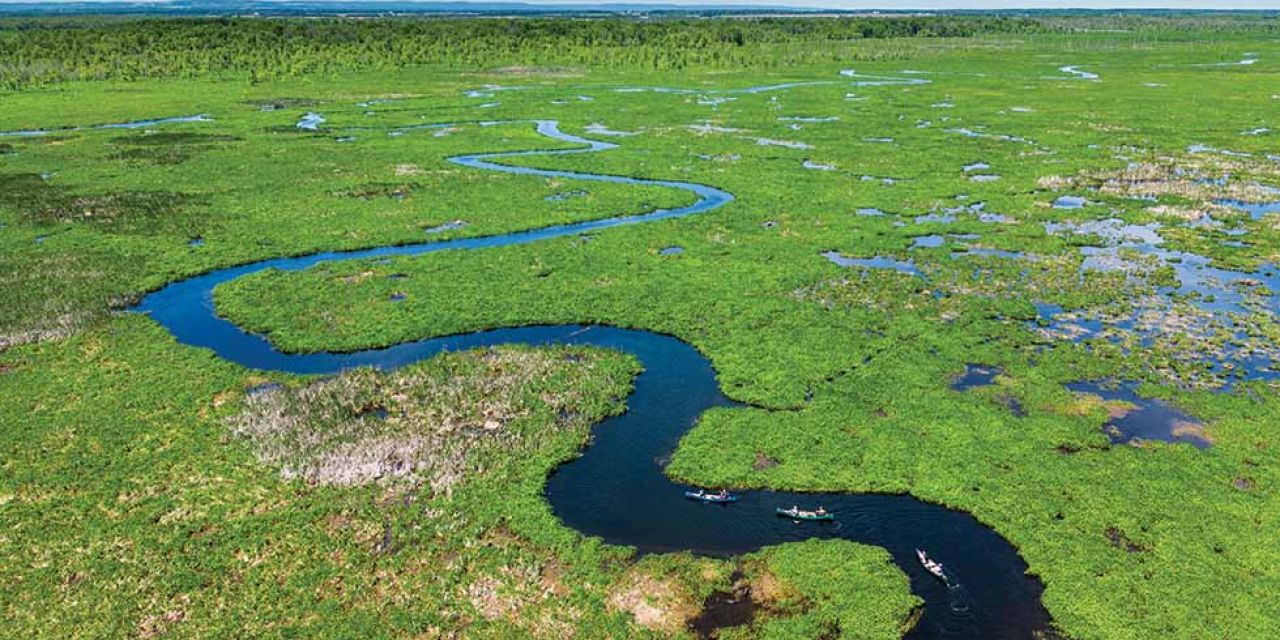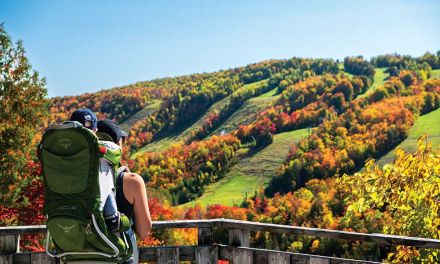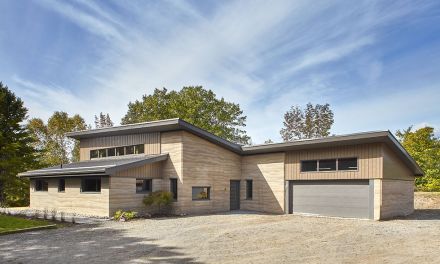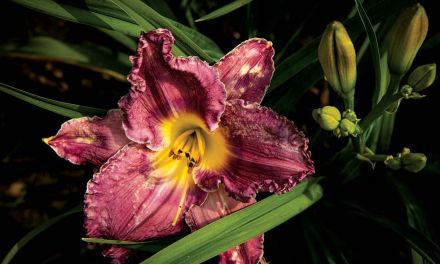Everglades of the North
by Cara Williams | photography by Clay Dolan
Navigating the waterways of the Minesing Wetlands is more than an adventure; it’s an exploration of one of Southern Ontario’s largest and most diverse ecosystems.
Chances are, you’ve driven past the Minesing Wetlands a dozen times or more. Highway 26 crosses the Nottawasaga River just east of Edenvale, and if you’re travelling at a good pace, you might not even notice the minor overpass. It’s particularly easy to miss in the summertime when the river reflects the big sky, and the water levels drop.
Last spring, Escarpment published an article titled “The Cleanest Water on Earth” that highlighted the vital role the Minesing Wetlands play in absorbing and filtering floodwaters during the spring thaw. Despite my familiarity with the wetlands, I had never truly explored the area—then came an opportunity to canoe from Willow Creek to the Nottawasaga River. By all accounts, the 20-kilometre voyage is picturesque, with wide open vistas framed by tall reeds and bulrushes, but we had been forewarned that navigating the passages that intersect across the unending expanse of the wetlands is tricky.
Indigenous peoples lived on these lands long before European settlers arrived. The wetlands provided abundant resources essential for their survival, with plenty of fish, game, and plant life ensuring a stable food supply. The waterways were also vital for trade and communication, especially during times of conflict. During the War of 1812, the web-like channels made it tough for enemy forces to navigate, giving those who knew the land a significant advantage. British troops and their Indigenous allies, notably the Iroquois Confederacy, utilized the complex river networks for movement and supplies.
Today, the Minesing Wetlands are touted as one of the most diverse and ecologically significant wetlands in Ontario. A living testament to the powerful forces of nature, it was shaped by glacial and post-glacial processes over the past 20 millennia. This incredible journey through time has led to the convergence of the Nottawasaga River, Mad River, Willow Creek, and Coates Creek. Spanning more than 15,000 acres, the wetland’s unique hydrology provides for an interconnected network of swamps, fens, bogs and marshes and is a hotspot for conservationists, recreation and tourism—especially for birding and eco-tours.
Even though I consider myself a competent paddler, I had heard stories of people getting lost in the swamp and being rescued by helicopter—or worse, spending a night out there. There were also tales about bloodsucking leeches and mosquito swarms so thick you couldn’t even see the canoe in front of you. And then there’s the wind…
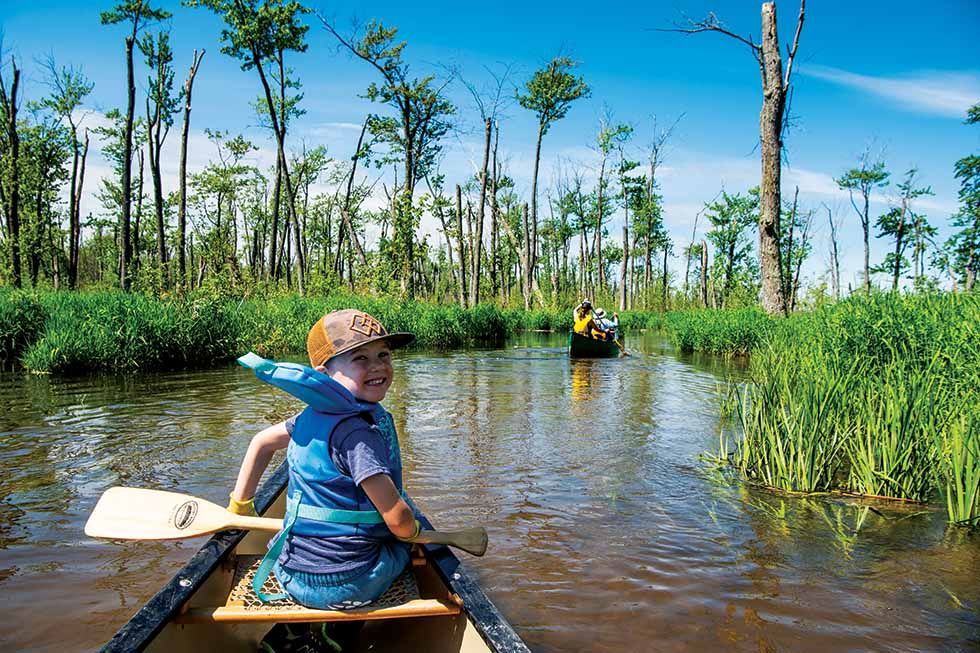
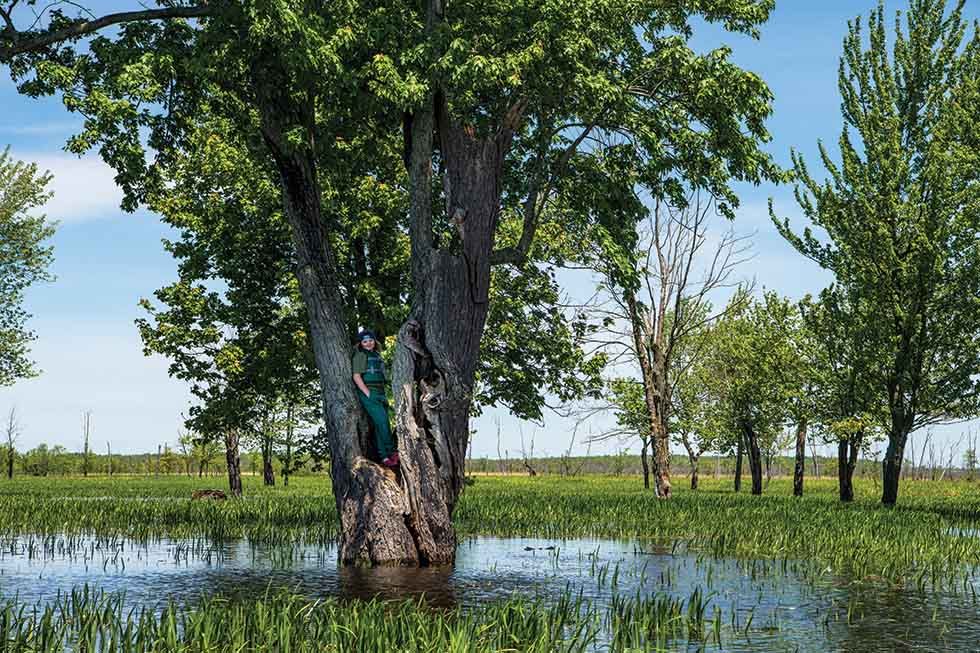
For our little adventure, we decided to heed the warnings— we enlisted the help of Free Spirit Tours, and our guide Jim met us at the Willow Creek put-in, located at the northeast corner of the wetlands. Free Spirit has been operating since 1998, providing authentic outdoor experiences with expert leaders who equip and teach participants the necessary skills for various activities. Jim arrived with a fleet of canoes, lifejackets, paddles, safety equipment, and, most importantly, knowledge of the creek, swamp, and river. Oh yeah, he brought bug spray too.
Almost immediately, we were thankful for having an experienced navigator—as the channels that intersect one another are akin to a maze. Occasionally, we spotted yellow, pink, and orange ribbons, but I was grateful we weren’t relying on them alone; the thick undergrowth had already swallowed some of the flimsy plastic markers.
The brisk current in Willow Creek worked in our favour, making paddling relatively effortless throughout the first leg of our tour. From time to time, we paused to let the water carry us along and to wait for the other boats to catch up. As soft grasses brushed against us from both sides of the narrow creek, we could almost imagine ourselves in the Florida Everglades.
The Minesing Wetlands are home to a stunning array of flora and fauna, many of which are rare, sensitive and/or near the limits of their geographical range. Over 400 species of plants have been identified here, with 11 considered provincially rare. Among the highlights are the localized patches of prairie white-fringed orchids and the largest pure stand of silver maple in Ontario. The wetlands also play a critical role in moderating flooding in the lower Nottawasaga River and the Town of Wasaga Beach, thanks to their reservoir-like hydrology. You can spot cattails, bulrushes, and sedges, which are crucial for maintaining the ecosystem’s health. These plants provide habitat and food for many species and help improve water quality by filtering pollutants and trapping sediments.
About three hours into our paddle, we found ourselves coasting beneath a canopy of healthy deciduous trees.
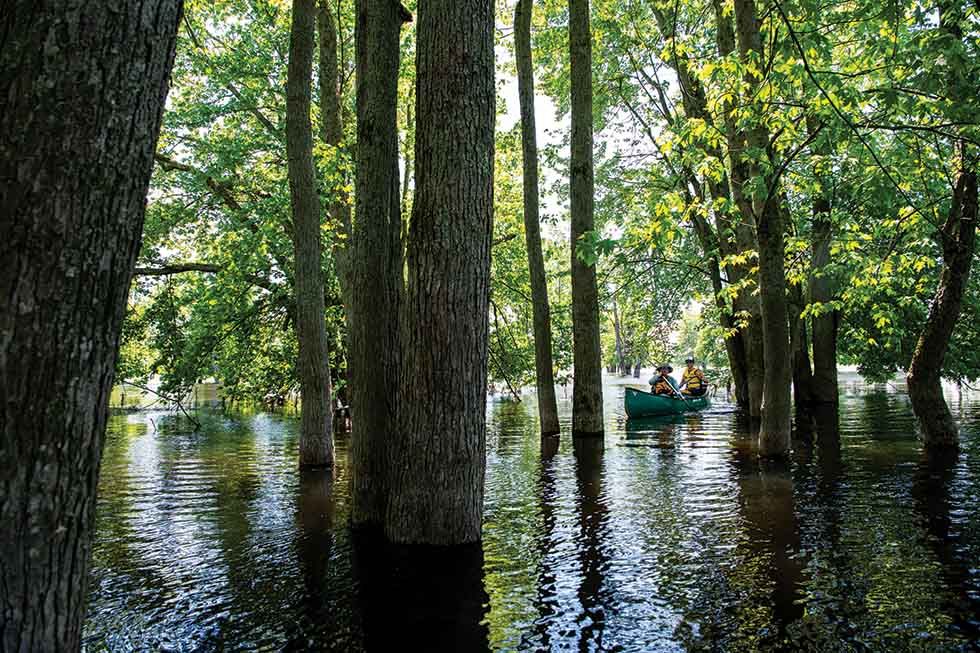
The wildlife is just as diverse—it’s home to over 206 species of birds, including over a hundred known breeders and migrants. As we paddled through the swamp, we encountered a stunning variety of birdlife, from rare Carolinian songbirds like the cerulean and golden-winged prothonotary warbler to northern species such as the sharp-shinned hawk, golden-crowned and ruby-crowned kinglet, myrtle warbler, and magnolia warbler.
At first glance, the long-dead standing trees that line the wetlands might seem forlorn or even out of place, but they actually support Ontario’s second-largest great blue heronry, with approximately 200 nests near the confluence of the Mad and Nottawasaga Rivers. One of the day’s highlights was spotting a bald eagle soaring overhead, along with several endangered least bitterns, the smallest members of the heron family in the Americas.
Every so often, there are reports of black bears and moose wandering through, adding a thrilling element to any adventure, although we didn’t spot any. The waterways are teeming with around 30 species of fish, mostly from the minnow family, but the Mad River and Nottawasaga River are vital migratory routes for Georgian Bay rainbow trout and Pacific salmon, which head to the upper Nottawasaga River Basin to spawn. The wetlands are also crucial spawning grounds for northern pike and walleye. Amphibians and reptiles are also plentiful here, with rare species like the wood, Blanding’s, and spotted turtles making their homes in the swamp.
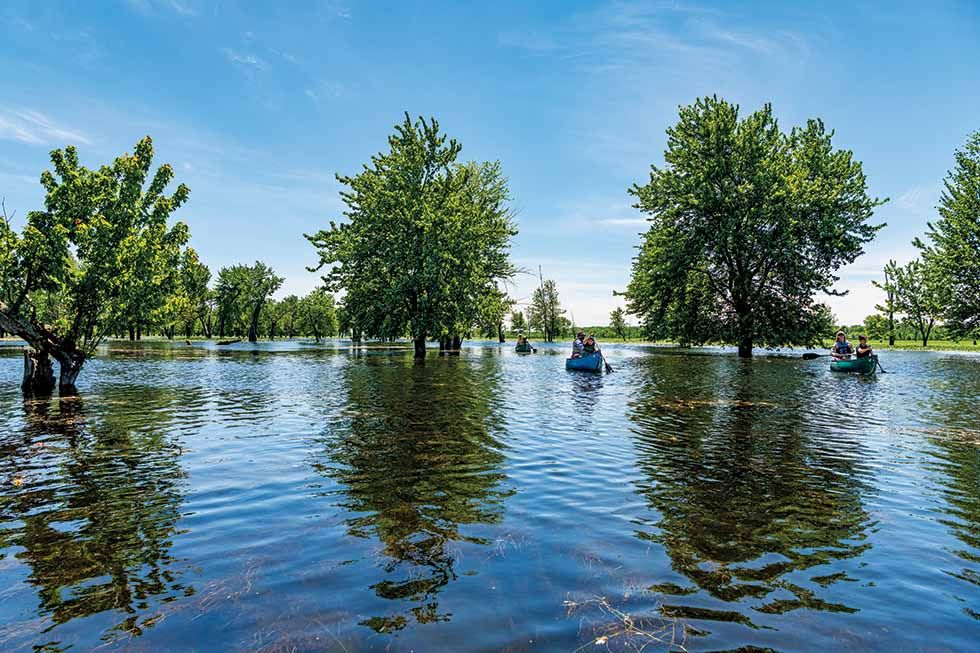
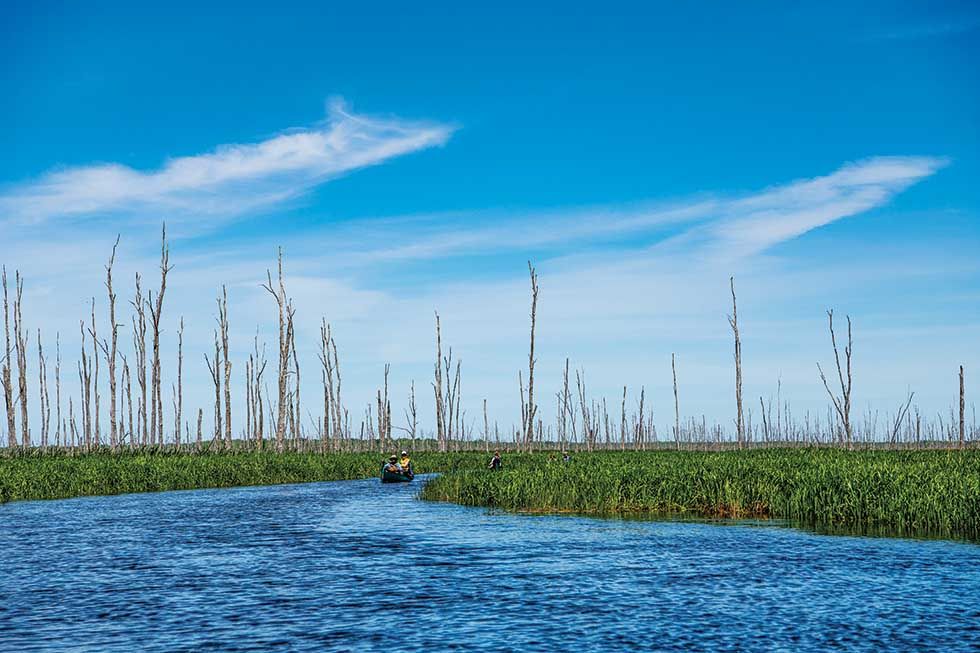
About three hours into our paddle, we found ourselves coasting beneath a canopy of healthy deciduous trees. At the confluence of the Nottawasaga River, the waterway became much wider and deeper than the creek. Oversized ferns and dense bushes lined the channels, and lush growth was everywhere—it felt like we were entering Narnia.
Dozens of photographs later, we continued along, ultimately stopping for lunch once the riverbank looked solid and dry enough to stand on. Even after being on the water for so long, we couldn’t believe that we were the only group enjoying the pristine wetlands—we didn’t see another soul for five hours.
Towards the end of our journey, we faced a moderate headwind sweeping across the farm fields. Given the relaxed pace for the majority of our trip, most of us relished the challenge and effort required to make headway. We soon reached our pick-up point in Edenvale, where our car was waiting.
A word of caution—paddling in the Minesing Wetlands is not for the faint of heart—the waterways are notoriously tricky, with many twists and turns that can easily disorient even experienced navigators. Hiring a guide from Free Spirit Tours was absolutely the right choice for us; Jim’s knowledge of the terrain and waterways ensured that we stayed on course and could fully appreciate the journey without the stress of getting lost. Although we found a few leeches on the bottom of one of the canoes, our feet and legs remained blissfully bloodsucker-free.
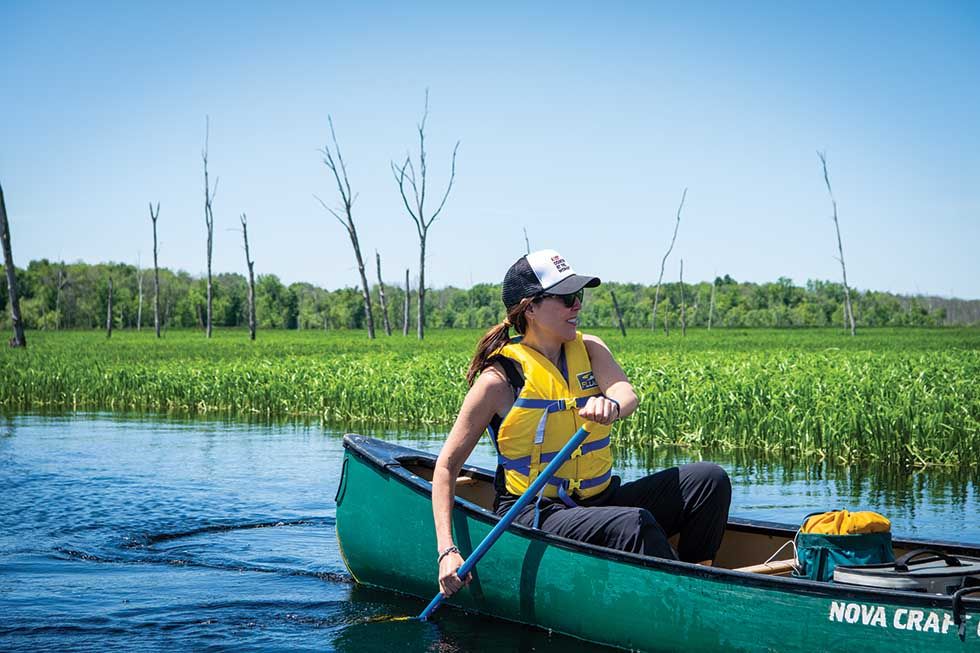
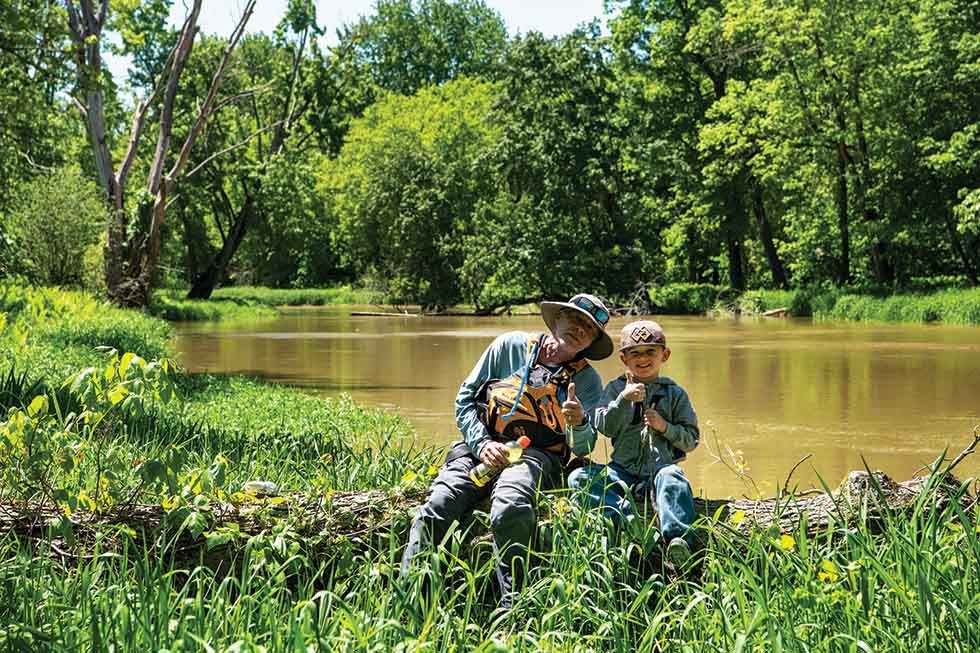

The experience also underscored the importance of conserving this remarkable area. Southern Ontario has already lost 70% of its natural wetland habitats, making the preservation of the Minesing Wetlands vital for maintaining its ecological integrity and historical significance. Conservation efforts have been ongoing to protect this environment from threats such as pollution, invasive species, and climate change. Organizations such as the Nature Conservancy of Canada, in partnership with the Nottawasaga Conservation Valley Authority, have been instrumental in these efforts, working to ensure that future generations can continue to experience the beauty and wonder of the wetlands.
Education and awareness are also key components of conservation. Guided tours, like the one we experienced, play a crucial role in fostering a deeper understanding and appreciation of the wetlands. By learning about the history, culture, and ecology of the Minesing Wetlands, visitors are more likely to support and advocate for their protection. E


